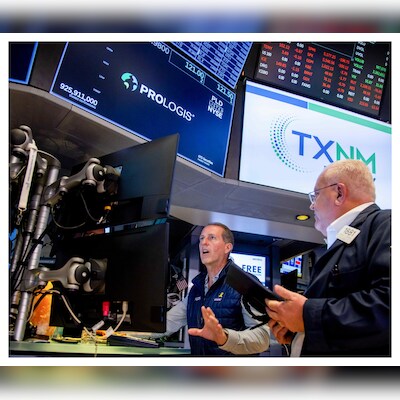)
Eight of the 11 S&P 500 sectors were lower, while Energy stocks hit a more than one-month high and were up 1.5 per cent. | Photo: Bloomberg
The benchmark S&P 500 and the Nasdaq traded near two-week lows on Wednesday as investors priced in a possible escalation in geopolitical tensions in the Middle East, while a survey allayed worries about a rapid cooldown in the US labor market.
Markets were wary as Israel and the US vowed to strike back after Iran attacked Israel on Tuesday, following which the S&P 500 and the Nasdaq logged their biggest one-day drops in nearly a month.
Click here to connect with us on WhatsApp
The Dow Jones Industrial Average gained 28.72 points, or 0.07 per cent, to 42,175.03, the S&P 500 lost 13.30 points, or 0.24 per cent, to 5,694.09 and the Nasdaq Composite lost 88 points, or 0.49 per cent, to 17,825.69.
Eight of the 11 S&P 500 sectors were lower, while Energy stocks hit a more than one-month high and were up 1.5 per cent.
Oil prices climbed more than 3 per cent as traders priced in possible supply disruptions from the oil-rich Middle East.
Chevron and Exxon Mobil added more than 1 per cent each.
Defense stocks such as Lockheed Martin and RTX were flat after the broader S&P 500 aerospace and defense index hit a record high on Tuesday.
“Sentiment is dominated by the risk of escalating conflict in the Middle East and there is a lack of information on how strong the Israeli response is going to be. That’s why the market is sort of not doing a lot,” said Jay Hatfield, portfolio manager at InfraCap.
The CBOE Volatility Index, Wall Street’s fear gauge, hovered near a three-week high and was last at 19.56.
Meanwhile, US private payrolls increased more than expected in September in further evidence that labor market conditions were not deteriorating.
Odds of a quarter-percentage-point rate reduction at the Fed’s November meeting are at 65.7 per cent, up from 42.6 per cent a week ago, according to the CME Group’s FedWatch Tool.
“The ADP report was strong and that might be mitigating the volatility, because we’re not in a complete information vacuum,” Hatfield said.
Comments from Fed policymakers including Beth Hammack and Alberto Musalem are scheduled through the day, while the focus will stay on Friday’s non-farm payrolls data for September.
Markets ended September higher after the US Federal Reserve kicked off its monetary-policy-easing cycle with an unusual 50-basis-point rate cut to shore up the jobs market.
A dockworkers’ strike on the East and Gulf coasts, costing the economy roughly $5 billion per day according to JPMorgan analyst estimates, entered its second day.
Some companies such as Walmart, Merit Medical Systems and McCormick said they had planned for the strike.
Tesla lost 4.7 per cent after reporting third-quarter vehicle deliveries below estimates.
Dow-component Nike slid 7.4 per cent after withdrawing its annual revenue forecast just as a new CEO is set to take charge.
Both stocks weighed heavily on the Consumer Discretionary sector, which was at the bottom with a 1.2 per cent loss.
(Only the headline and picture of this report may have been reworked by the Business Standard staff; the rest of the content is auto-generated from a syndicated feed.)
First Published: Oct 02 2024 | 11:26 PM IST















Leave a Reply